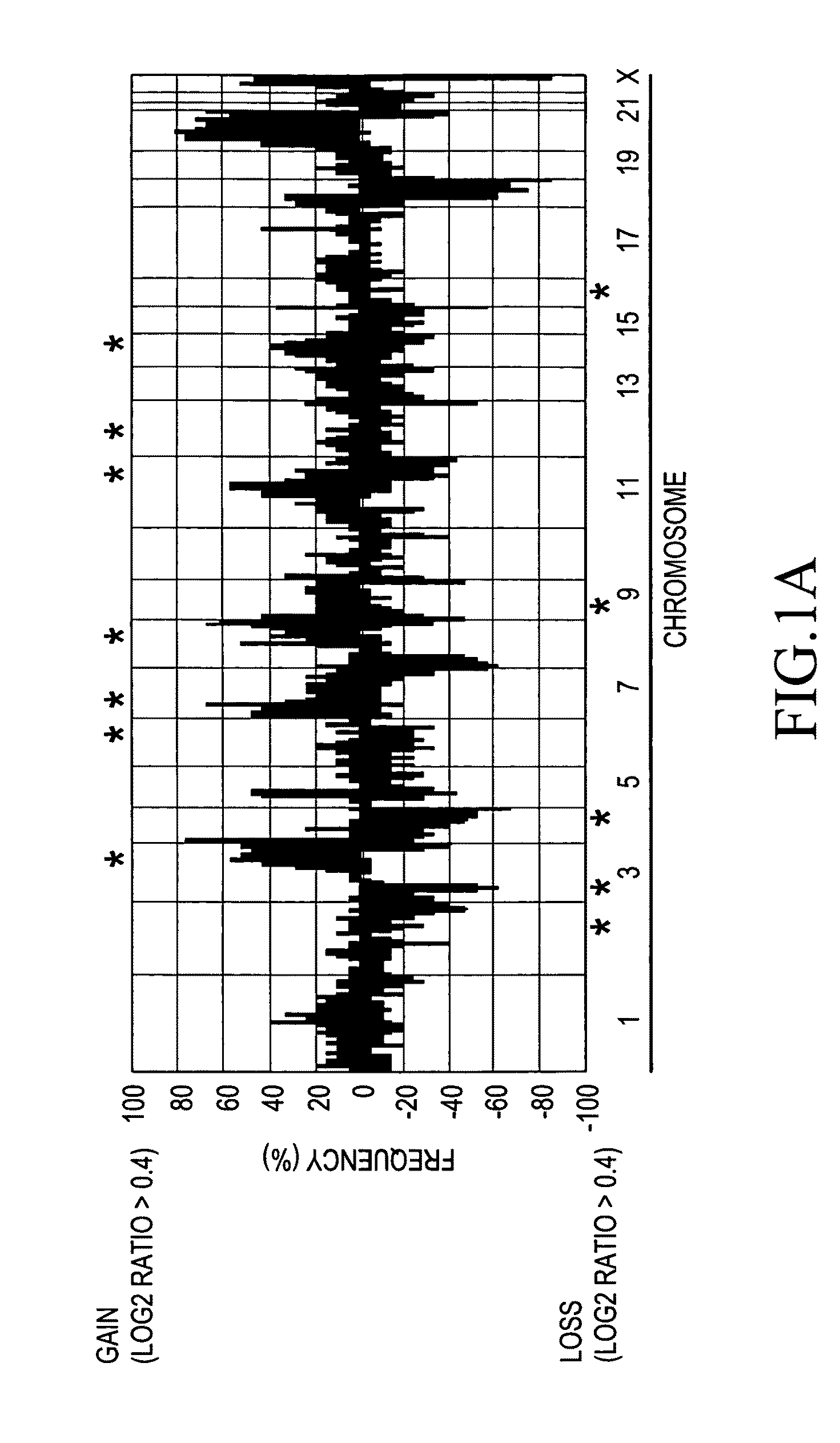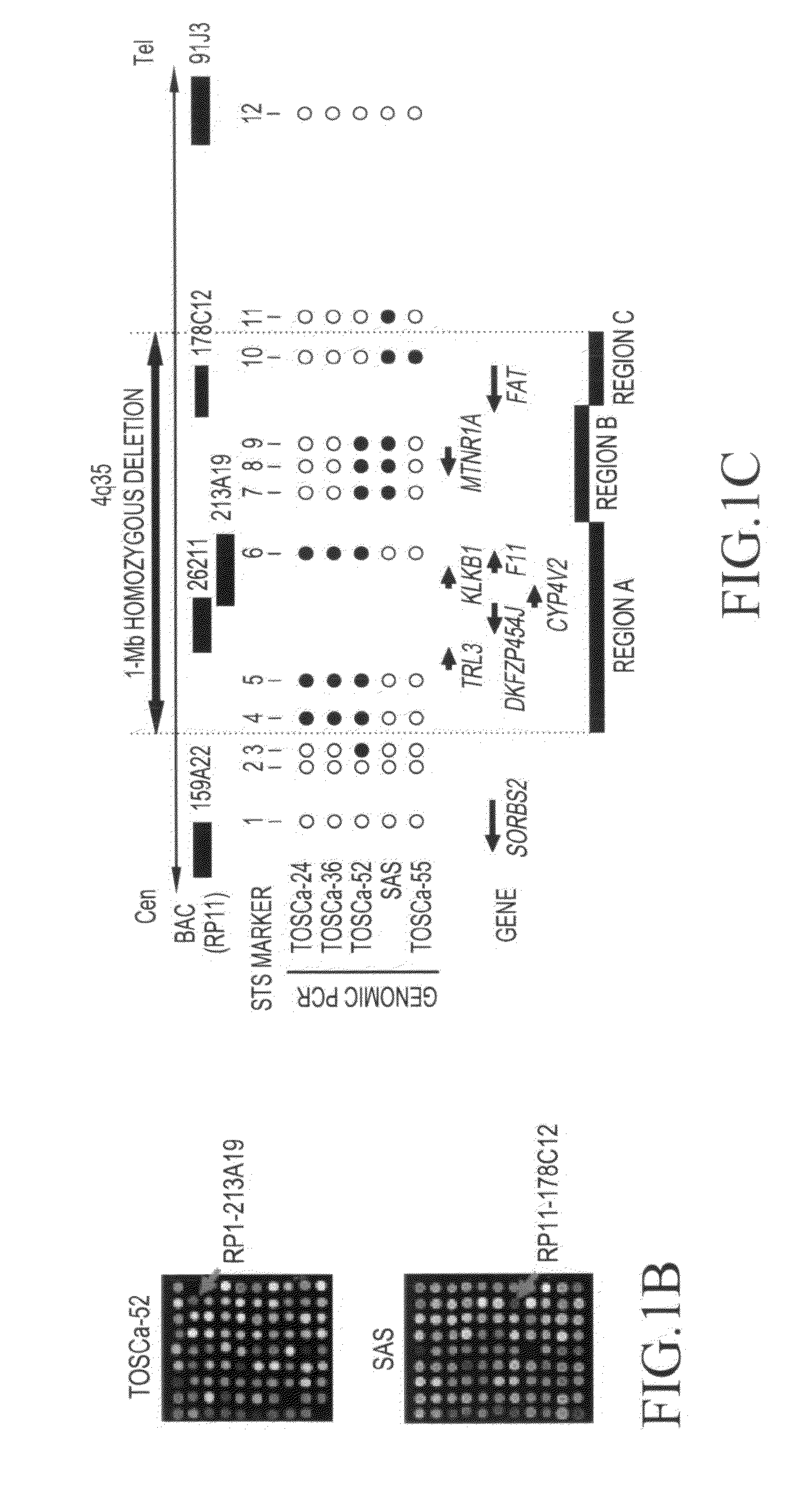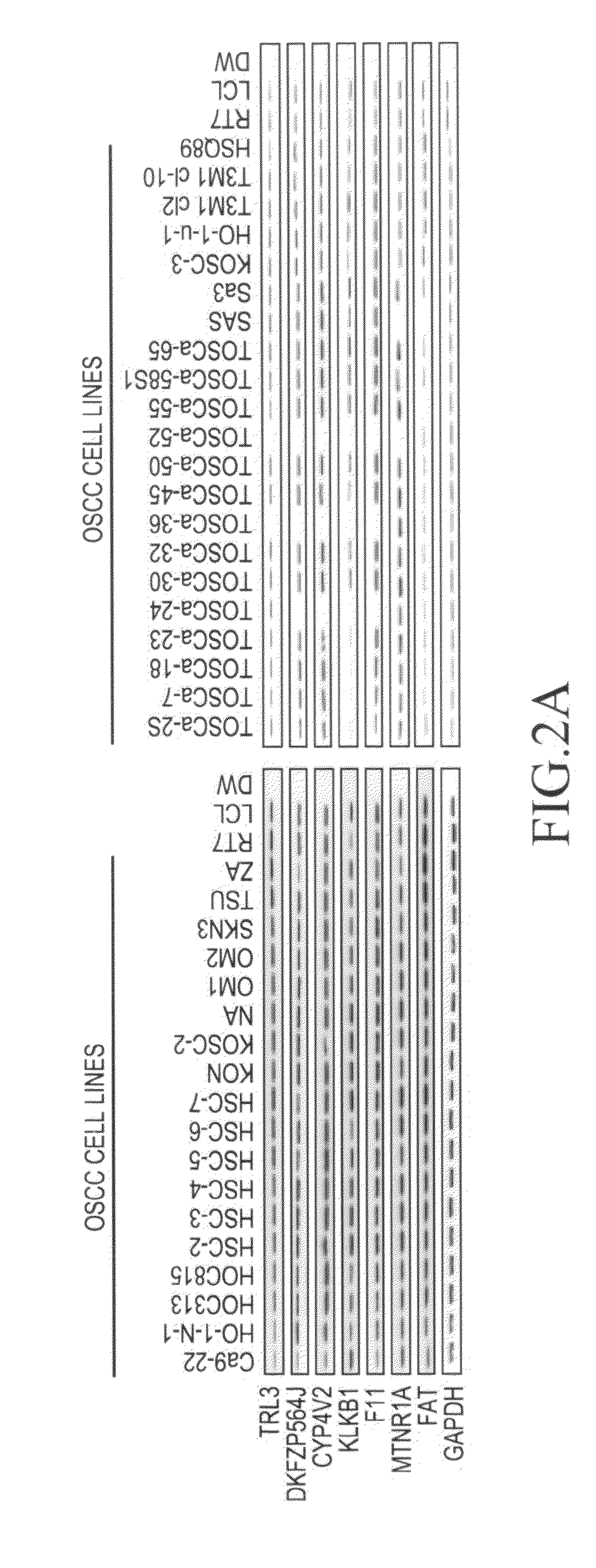Method for detecting oral squamous-cell carcinoma
a squamous cell carcinoma and oral squamous cell technology, applied in the field of detecting cancer, can solve the problems of unimproved cancer prognosis, limited methods, and large amount of time and labor required for an operation, and achieve the effect of suppressing the proliferation of oral squamous cell carcinoma
- Summary
- Abstract
- Description
- Claims
- Application Information
AI Technical Summary
Benefits of technology
Problems solved by technology
Method used
Image
Examples
example 1
Gene Alteration in Oral Squamous-Cell Carcinoma
[0082]In order to detect a novel gene alteration in oral squamous-cell carcinoma, CGH array analysis was made using genomic DNAs prepared from 21 types of oral squamous-cell carcinoma cell lines obtained by eliminating the initial 18 types of cell lines from 25 types of oral squamous-cell carcinoma cell lines (OM-1, OM-2, TSU, ZA, NA, Ca9-22, HOC-313, HOC-815, HSC-2, HSC-3, HSC-4, HSC-5, HSC-6, HSC-7, KON, SKN-3, HO-1-N-1, KOSC-2, Sa3, SAS, KOSC-3, HO-1-u-1, T3M1C12, T3M1CI-10, and HSQ89) and from 14 types of oral squamous-cell carcinoma cell lines (Tosca-2S, 7, 18, 23, 24, 30, 32, 36, 45, 50, 52, 55, 58S1, and 65), and employing MGC Cancer Array-800, and MGC Whole Genome Array-4500. In addition, a genome extracted from the cell line (RT7) derived from normal oral epithelium was labeled with Cy5 as a control. Genomic DNAs prepared from the above oral squamous-cell carcinoma cell lines were used as test DNAs and labeled with Cy3. Specifi...
example 2
Isolation of Gene Contained in Deletion Region of Chromosome 4q35 of Oral Squamous-Cell Carcinoma
[0086]In order to determine the range of a homozygous deletion region in oral squamous-cell carcinoma cells (TOSCa-24, 36, 52, 55, and SAS), in which homozygous deletion of chromosomal region 4q35 had been confirmed with the use of array CGH, a series of STS markers (1: SHGC-8050; 2: RH48688; 3: SHGC-156018; 4: RH45826; 5: SGGC-140659; 6: GDB-315917; 7: SHGC-50723; 8: SHGC-140376; and 9: WI-3160) were used to conduct genomic PCR. As a result, it was found that there are 3 homozygous deletion regions in a region of approximately 1 Mb (FIG. 1c).
[0087]Moreover, from the results of the CGH array and human genome database (genome.uc / sc / edu / ), it was confirmed that there are 7 genes (TRL3, DKFZP564J gene, KLKB1 gene, CYP4V2 gene, F11 gene, MTNR1A gene, and FAT gene) in this region.
[0088]Furthermore, in order to confirm that these genes are homozygously deleted, the aforementioned 39 types of c...
example 3
Disappearance of MTNR1A mRNA Expression in Oral Squamous-Cell Carcinoma Cell Lines
[0089]In order to determine the expression level of the mRNA of the aforementioned 7 types of genes (the TRL3 gene, the DKFZP564J gene, the KLKB1 gene, the CYP4V2 gene, the F11 gene, the MTNR1A gene, and the FAT gene) in each of the aforementioned 39 cell lines, an immortalized cell line RT7 of normal oral epithelial cells, and the primary-cultured epithelial cells from normal oral cavity mucosa, reverse transcriptase (RT)-PCR was carried out.
[0090]Specifically, single-stranded cDNA was synthesized from the RNA extracted from each cultured cell line using the SuperScript First-Strand Synthesis System (Invitrogen). PCR was then performed using primer sequences (SEQ ID NOS: 1-44) listed in Table 3. Moreover, a glyceraldehyde-3-phosphate dehydrogenase (GAPDH) gene was used as a control.
[0091]
TABLE 3Primer sequences used in this studyMethodTargetForward primer (SEQ ID NO)Reverse primer (SEQ ID NO)Genomic P...
PUM
| Property | Measurement | Unit |
|---|---|---|
| size | aaaaa | aaaaa |
| concentration | aaaaa | aaaaa |
| concentration | aaaaa | aaaaa |
Abstract
Description
Claims
Application Information
 Login to View More
Login to View More - R&D
- Intellectual Property
- Life Sciences
- Materials
- Tech Scout
- Unparalleled Data Quality
- Higher Quality Content
- 60% Fewer Hallucinations
Browse by: Latest US Patents, China's latest patents, Technical Efficacy Thesaurus, Application Domain, Technology Topic, Popular Technical Reports.
© 2025 PatSnap. All rights reserved.Legal|Privacy policy|Modern Slavery Act Transparency Statement|Sitemap|About US| Contact US: help@patsnap.com



